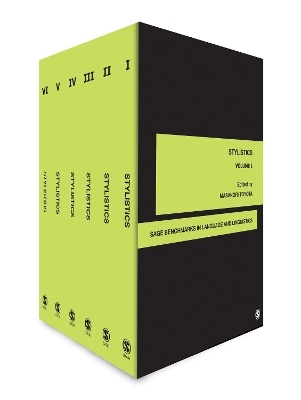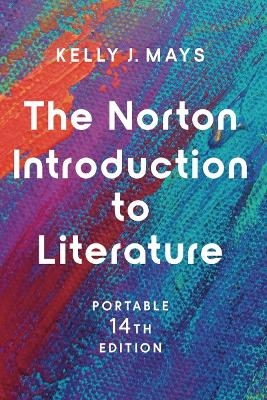
Stylistics
Sage Publications India Pvt Ltd
978-93-5280-662-1 (ISBN)
- Keine Verlagsinformationen verfügbar
- Artikel merken
Stylistics is a branch of applied linguistics which studies style, especially in works of literature. Above all, it has long fascinated academics working at the interface between language and literature, as is attested in the opening chapter of Linguistics and Literary History by Leo Spitzer (1948).
The present major work is organized into four parts across six volumes. Part 1 deals with the general issues of Theories and Methods from formalist stylistics to corpus stylistics, cognitive stylistics, and creative stylistics.
Part 2 focuses on the ‘Aspects of Stylistics’, such as foregrounding, transitivity, creativity, thought presentation, ideology, metaphor, collocation, identification and contextualization.
‘Stylistics of Prose’ is the topic of Part 3, which includes articles on stylistic analysis of prose, British and American fiction and newspapers.
Part 4 is entitled ‘Stylistics of Verse and Drama’. Included in this volume are articles on stylistic analysis of poetry and drama.
It is hoped that this SAGE Major Work will be a happy addition to the field of language and literature.
SAGE Benchmarks in Language and Linguistics presents six-volume collections that bring together the most authoritative and influential research in language and linguistics. Traversing the full breadth of traditional scholarly and applied perspectives, the series is edited by world-leading experts in their fields. Each set starts with a contextualizing introduction from the editor and systematically presents classic and contemporary articles that map out the history, debates, theory and methods core to the field. This series presents the ‘gold standard’ for university libraries throughout the world who are seeking to solidify their linguistics reference collections. Masanori Toyota is Emeritus Professor of Kyoto University and Kansai Gaidai University. He was educated at Okayama University, Kyoto University and University College London. He is one of the leading linguists in the field of stylistics in Japan and was the organiser of the annual conference of PALA (Poetics and Linguistic Association) held for the first time in Asia at Kansai Gaidai University in 2007. He is the author of Styles of English (Kenkyusha Press), the co-editor of New Horizons in English Language Teaching: Language, Literature and Education (Kansai Gaidai University Press), and the translator of Linguistics and the Novel by Roger Fowler (Kinokuniya Press). He is a former president of the Modern English Association.
VOLUME 1
Appendix of Sources
Editors’ Introduction
The Development of Stylistics
Linguistics and Literary History - Leo Spitzer
Argument II. Literature and Linguistics - Roger Fowler and F W Bateson
Argument II. (continued) Language and Literature - Roger Fowler and F W Bateson
Stylistic Analysis - David Crystal and Derek Davy
A Method of Analysis and Some Examples - Geoffrey N Leech and Michael H Short
Style and Interpretation in Hemingway’s “Cat in the Rain" - Ronald Carter
Style and Purpose - Randolph Quirk and Gabriele Stein
Using a Corpus for Stylistic Research: Speech and Thought Presentation - Mick Short, Elena Semino and Jonathan Culpeper
Multivariate Analysis and the Study of Style Variation - David L Hoover
The Web-based Language and Style Course - Mick Short, Beatrix Busse and Patricia Plummer
Style in Fiction Revisited: The Beginnings of Great Expectations - Geoffrey Leech
Narrative Progression in the Short Story: First Steps in a Corpus Sylistic Approach - Michael Toolan
The Cognitive Poetics of Literary Resonance Peter Stockwell
VOLUME 2
Appendix of Sources
Rhetorical Pedagogy: Teaching Students to Write a Stylistics Paper - Michael Burke
Just What Is Narrative Urgency - Paul Simpson
Towards an Integrated Corpus Stylistics - Dan McIntyre
From Reading to Writing: Creative Stylistics as a Methodology for Bridging the Gap Between Literary Appreciation and Creative Writing in ELT - Yoshifumi Saito
Pedagogical Stylistics in Multiple Foreign Language and Second Language Contexts - Gary G Fogal
Reader Response Research in Stylistics - Sara Whiteley and Patricia Canning
Part 2: Various Concepts of Stylistics
Stylistics and Generative Grammars - J P Thorn
Meaning and World View - Roger Fowler
Subjectivity as a Text-Type Marker in Historical Stylistics - Irma Taaviotsainen
Introduction - Jean-Paul Vinay and Jean Darbelnet
‘Linguistic Signals and Interpretative Strategies: Linguistic Models in Performance with Special Reference to Free Indirect Discourse - Monika Fludernik
Stylistic Analysis and Relevance Theory - Billy Clark
Women Beware Women: Detective Fiction and Critical Discourse Stylistics - Urszula Clark and Sonia Zyngier
Evidentiality and Affect: A Quantitative Approach - Greg Watson
Towards a Methodology of Investigating the Style of a Literary Translation - Mona Baker
VOLUME 3
Appendix of Sources
Parody and Style - Seymour Chatman
Altered Texts, Altered Worlds, Altered Styles - David L Hoover
Repetition in Free Indirect Style: A Dialogue of Minds? - Violeta Sotirova
Lines on Feeling: Foregrounding, Aesthetics and Meaning - Willie van Peer, Jèmeljan Hakemulder and Sonia Zyngier
Style in Interior Monologue: Virginia Woolf’s “The Mark on the Wall - Geoffrey Leech
Deixis and Fictional Minds - Elena Semino
Text World Theory, Real Readers and Emotional Responses to The Remains of the Day - Sara Whiteley
The Social Life of Style - Emma Moore
Repetition, Difference and Chiasmus in John McGahern’s Narratives - Michael C Prusse
Towards a Musical Stylistics: Movement in Kate Bush’s ‘Running Up That Hill’ - Massimiliano Morini
Mind-Modelling with Corpus Stylistics in David Copperfield - Peter Stockwell and Michaela Mahlberg
Revisiting Text World Theory and Extended Metaphor: Embedding and Foregrounding Extended Metaphors in the Text Worlds of the 2008 Financial Crash - Sam Browse
A Comparable Comparison? A Corpus Stylistic Analysis of the Italian Translation of - Julian Barnesand and Jane Helen Johnson
Narrativity and Creativity in Oral Storytelling: Co-constructing a Story with the Audience - Soe Marlar Lwin
Part 3: Stylistics of Prose
James Joyce: Dubliners - John Russell
VOLUME 4
Appendix of Sources
Editors’ Introduction
Prose Devices - Ronald Carter and Walter Nash
Noun Phrase Name Appositions - Andreas H Jucker
A Stylistic Analysis of Middlemarch: “Polyphony” in the Context of “Pre-Modernism” - Masayuki Teranishi
Point of View and Semantic Prosodies in Virginia Woolf’s To the Lighthouse - Svenja Adolphs and Ronald Carter
Chandler’s American Style - Susan Peck MacDonald
Towards a Stylistic Typology of Narrative Gaps: Knowledge Gapping in Flannery - O’Connor’s Fiction
′Creation from Nothing′: A Foregrounding Study of James Joyce’s Drafts for Ulysses - Paul Sopcak
Mythology and History: A Stylistic Analysis of The Lord of the Rings - Robin Anne Reid
The Roots of Literary Style: Joyce’s Representation of Consciousness in - Ulysses Violeta Satirova
Point of View in First-Person Narratives: A Deictic Analysis of David Copperfied - Massimiliano Morini
Repetition, Difference and Chiasmus in John McGahern’s Narratives - Michael C Prusse
Is Style in Short Fiction Different from Style in Long Fiction? - Michal Toolan
Reading Dickens’s Characters: Employing Psycho-Linguistic Methods to Investigate the Cognitive Reality of Patterns in Text - Michaela Mahlberg, Kathy Conklin and Marie-Josés Bison
How Is Mrs Ramsay Thinking?: The Semantic Effects of Consciousness Presentation Categories Within Free Indirect Style - Eric Rudquist
Connectives ‘But’ and ‘For’ in Viewpoint Shifting in Woolf’s To the Lighthouse - Reiko Ikeo
VOLUME 5
Appendix of Sources
Dual Textual Dynamics and Dual Readerly Dynamics: Double Narrative Movement in Mansfield’s “Psychology” - Dan Shen
Attributing Minds to Vampires in Richard Matheson’s I Am Legend - Louise Nutall
Remember and Forget in Dan Brown’s Angels and Demons: A Corpus-Informed Account - Ernestine Lahey
Midlands Cadences: Narrative Voices in the Work of Alan Sillitoe - Jeremy Scott
A Corpus-Stylistic Approach to Dickens’s Use of Speech Verbs: Beyond Mere Reporting - Pablo Ruano San Segundo
Part 4: Stylistics of Verse and Drama
Taking a Poem to Pieces - J McH Sinclair
Roman Jakobson’s Verbal Analysis of Poetry Paul Werth
Discourse Analysis and the Analysis of Drama Mick Short
Sound and the Pattern of Poetic Meaning - Walter Nash
Poetry and Conversation: An Essay in Discourse Analysis - Ronald Carter
Pronouns as Address and Social Negotiation in As You Like It - Clara Calvo
Grounded Spaces: Deictic-Self Metaphors in the Poetry of Emily Dickinson - Margaret H Freeman
Barometer Couple’: Balance and Parallelism in Margaret Atwood’s Power Politics - Pilar Somacarrera
A Cognitive Approach to Characterization: Katherina in Shakespeare’s The Taming of the Shrew - Jonathan Culpeper
VOLUME 6
Appendix of Sources
A Cognitive Rhetoric of Poetry and Emily Dickinson - Craig Hamilton
Foregrounding in Poetic Discourse Between Derivation and Cognitive Constraints - Yashayahn Shen
The Role of Style in Reader-Involvement: Deictic Shifting in Contemporary Poems - Leslie Jeffries
What′s in a Clause? Milton′s Participial Style Revisited - Gareth Twose
Negation and the Creation of Implicit Meaning in Poetry - Lisa Nahajec
The Stylistics of Poetry: Walter de la Mare’s “The Listeners” - Katie Wales
“Public-House Confidence”′: The Indispensability of Sound Patterns - Tom Barney
Multimodality of the Study of Popular Drama - Kay Richardson
A Tragic Harp: Ritual, Irony and Myth in the War Poetry of Wilfred Owen - William Kevin Penny
Translating Celan’s Poetics of Silence - Jean Boase-Beier
About the Heart, Where it Hurt exactly, and How Often - Joanna Gavins
Creating a Film Poem with Stylistic Analysis: A Pedagogical Approach - Kieran O’Halloran
I Will Proclaim Myself What I Am: Corpus Stylistics and the Language of Shakespeare’s Soliloquies - Sean Murphy
oride lesgo eckshun’: Spelling Foregrounding in the Experimental Poetry of E. E. Cummings - Eva María and Gómez-Jiménez
“Out of the Forest I Come”: Lyric and Dramatic Tension in The World’s Wife - Shelley Roche-Jacques
Towards Characterizing a Type of Aggravated Impoliteness, with Examples From Timon of Athens - Juhani Rudanko
Difficult Poetry Processing: Reading Times and the Narrative Hypothesis - David Castiglione
| Reihe/Serie | SAGE Benchmarks in Language and Linguistics |
|---|---|
| Verlagsort | New Delhi |
| Sprache | englisch |
| Maße | 158 x 241 mm |
| Gewicht | 4080 g |
| Themenwelt | Geisteswissenschaften ► Psychologie |
| Geisteswissenschaften ► Sprach- / Literaturwissenschaft ► Anglistik / Amerikanistik | |
| Geisteswissenschaften ► Sprach- / Literaturwissenschaft ► Literaturwissenschaft | |
| Geisteswissenschaften ► Sprach- / Literaturwissenschaft ► Sprachwissenschaft | |
| Sozialwissenschaften ► Kommunikation / Medien ► Kommunikationswissenschaft | |
| ISBN-10 | 93-5280-662-X / 935280662X |
| ISBN-13 | 978-93-5280-662-1 / 9789352806621 |
| Zustand | Neuware |
| Haben Sie eine Frage zum Produkt? |
aus dem Bereich


